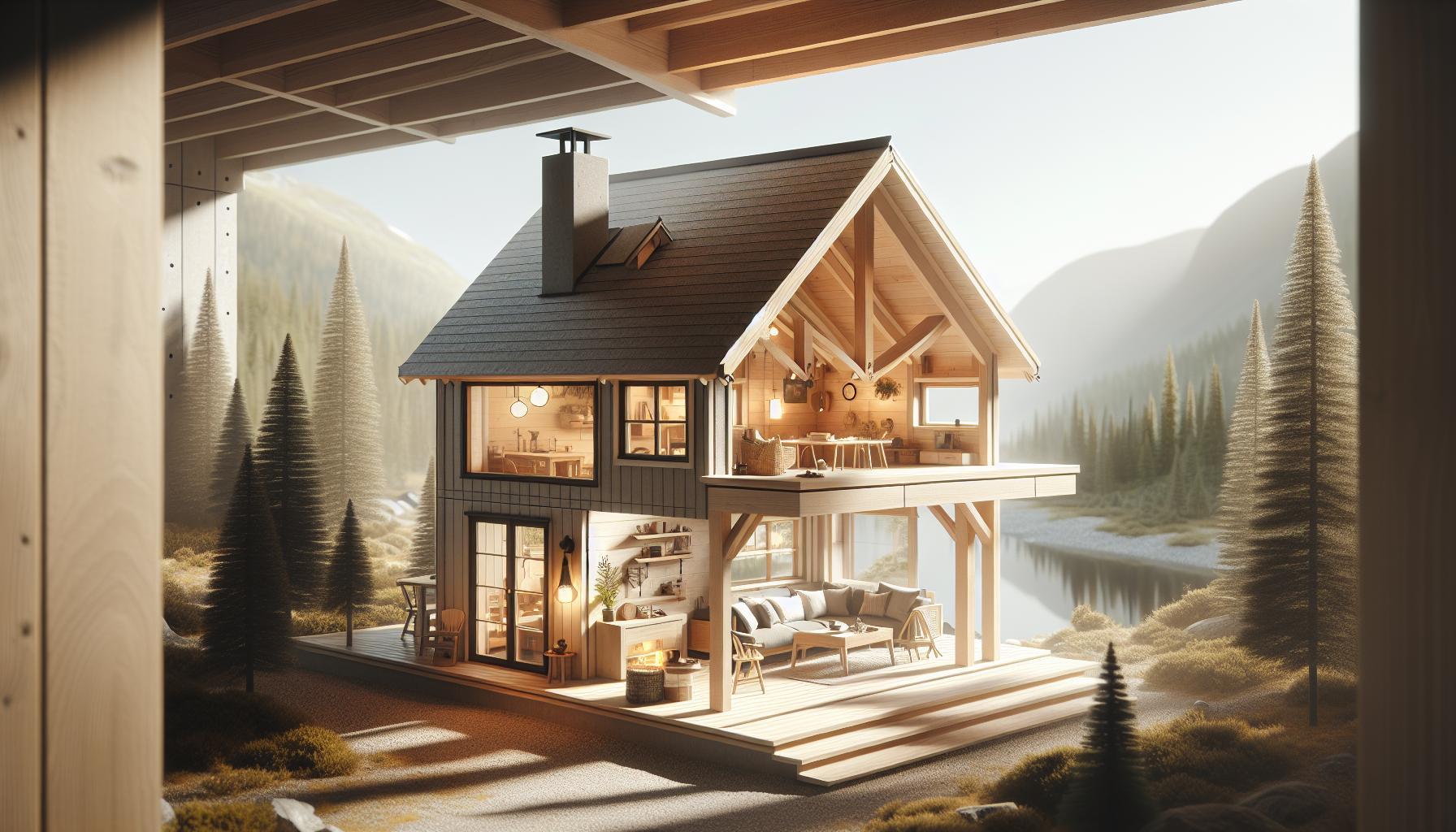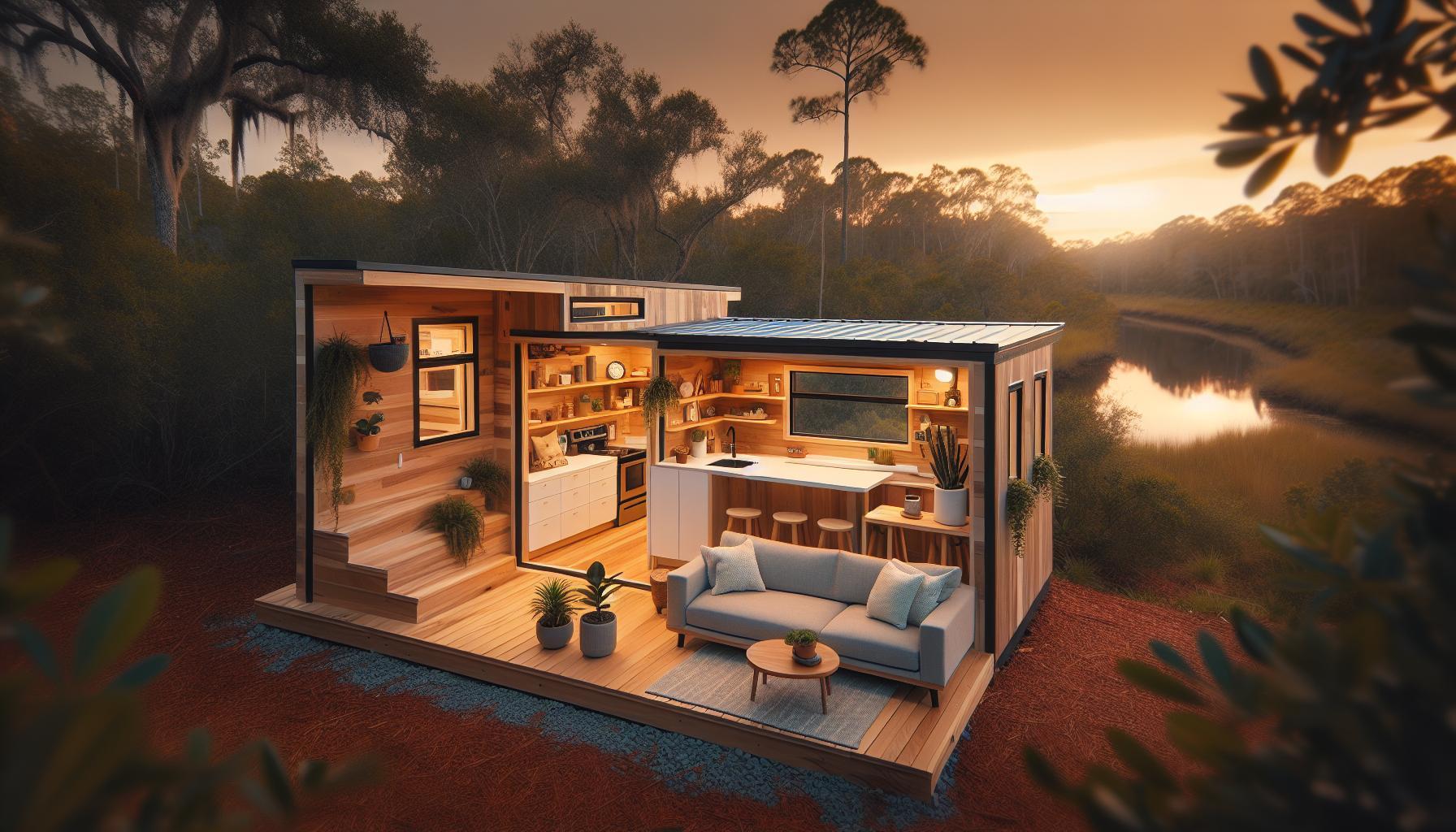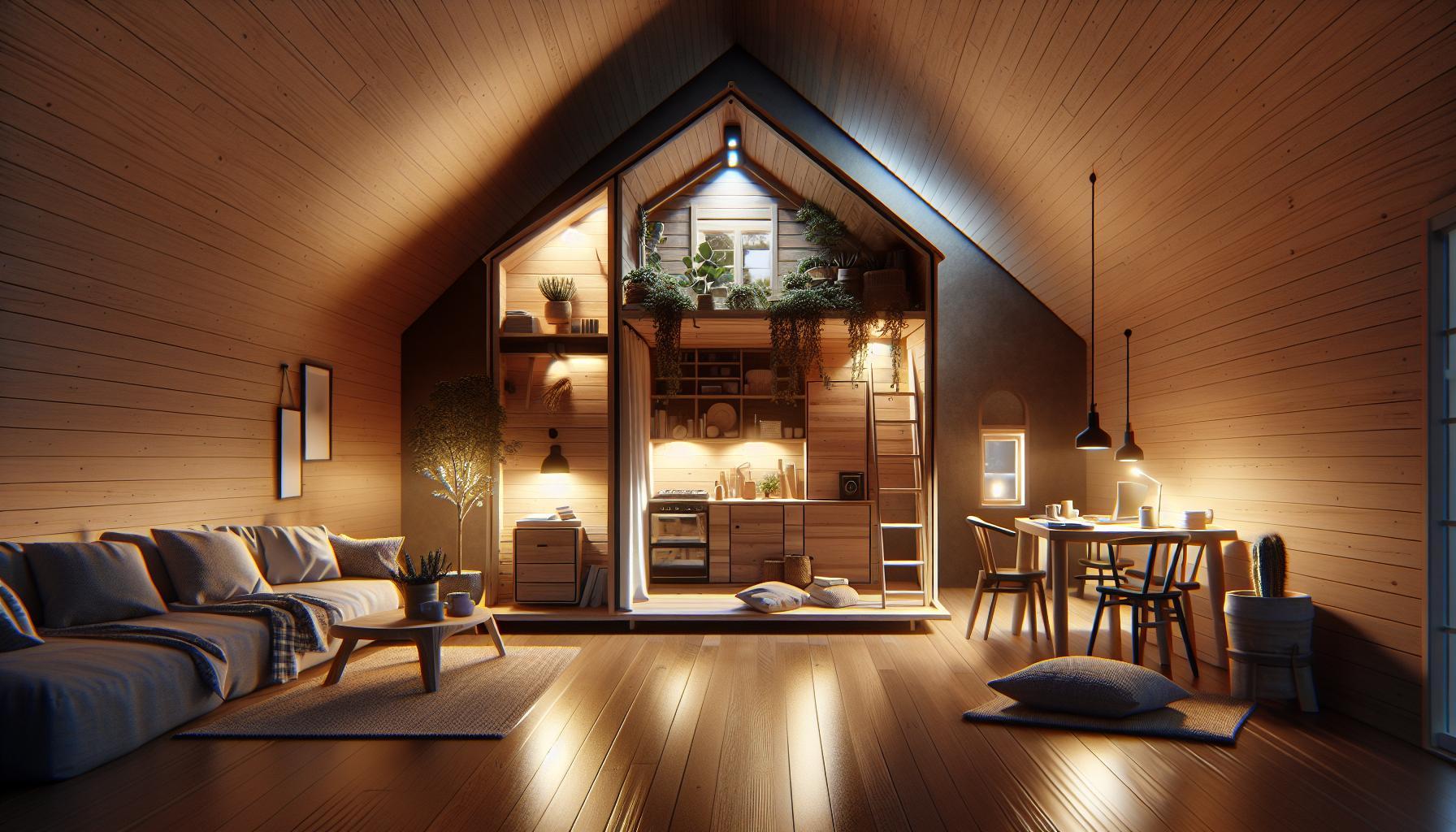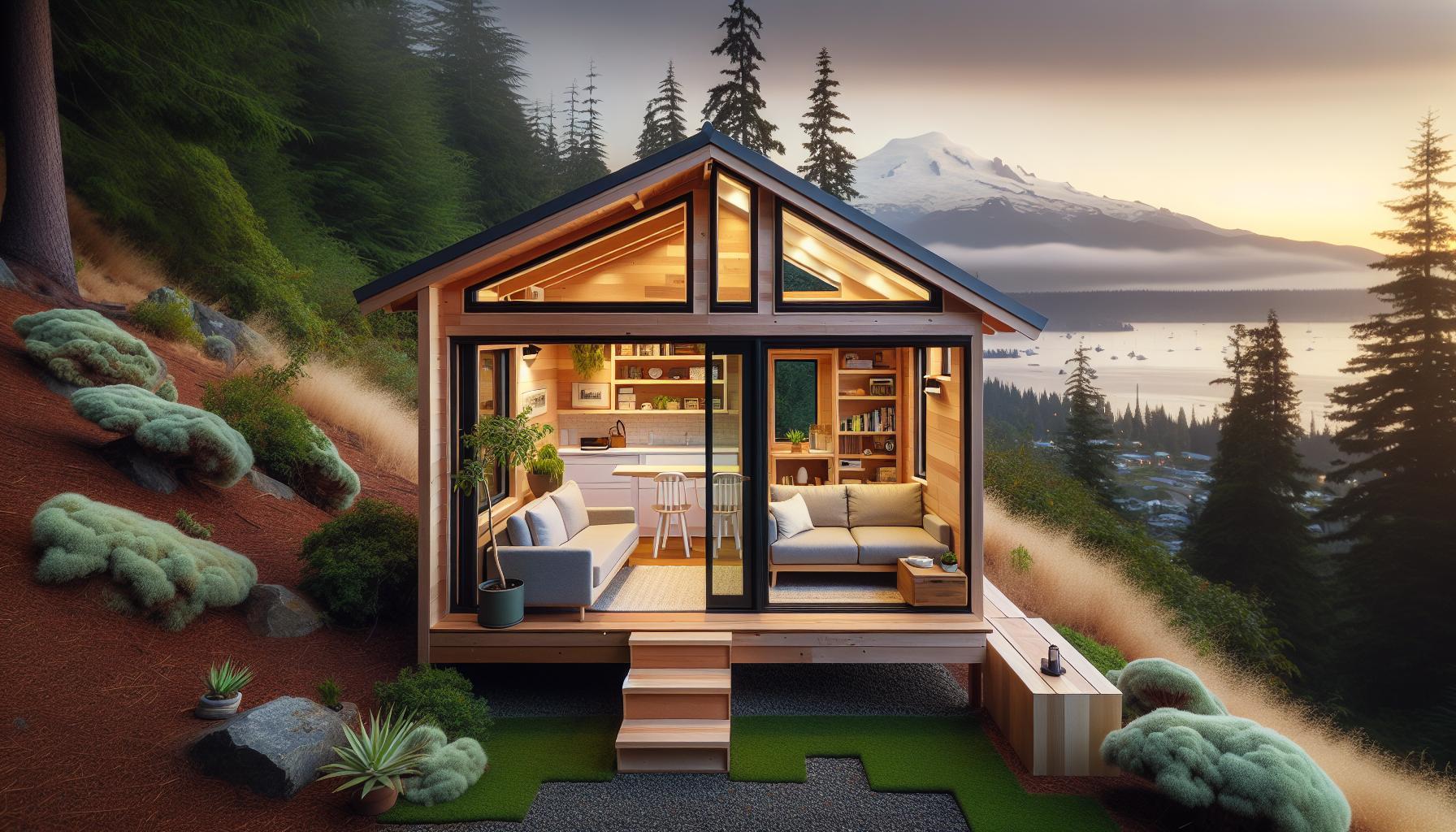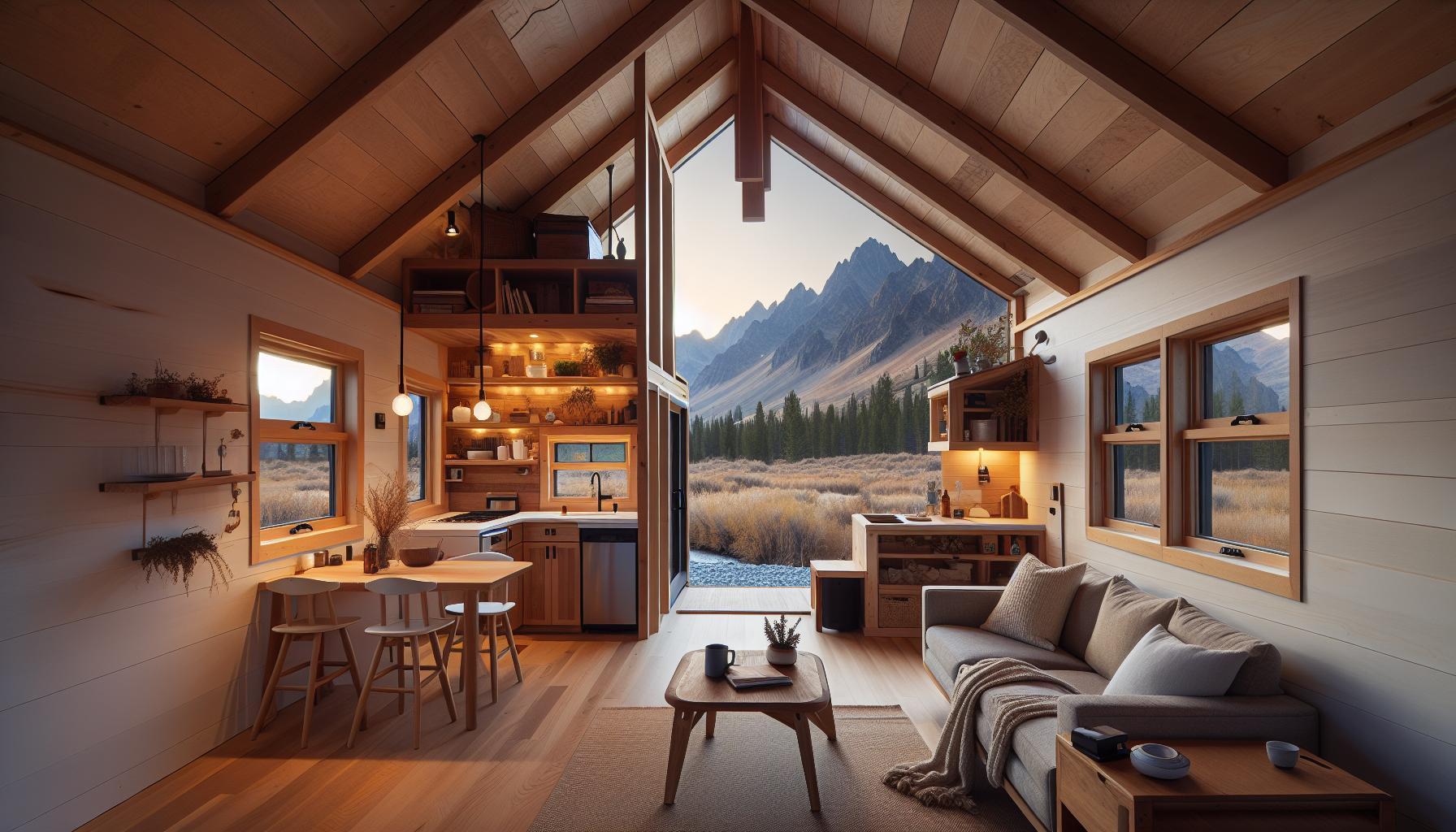As the tiny house movement gains momentum across Canada, prospective owners frequently enough face a maze of regulations that dictate whether they can legally reside in their compact homes. Understanding provincial rules is crucial for anyone considering this minimalist lifestyle,ensuring compliance while embracing freedom and sustainability in housing choices.
Understanding Tiny House Regulations: A provincial Overview
Undoubtedly,the tiny house movement is transforming the way many people think about living,investing in real estate,and embracing minimalism,but one of the most pressing questions that arise is,”Are tiny houses legal in Canada?” Understanding the regulatory landscape across different provinces is key to ensuring that you not only find your dream tiny home but also abide by local laws. Canada is a vast country with a diverse set of rules that can vary substantially from one province to another,making it imperative to decode the regulations that apply to tiny homes nationally and regionally.
provincial Snapshots: Navigating Regulations
Across Canada, each province offers unique insights and challenges concerning tiny home regulations. Below is a breakdown of the current stance in select provinces:
| Province | Legal Status | key Regulations |
|---|---|---|
| British Columbia | Generally Permitted | Must comply with local zoning laws; tiny homes as secondary dwellings can be allowed. |
| Alberta | Varying Acceptance | Regulations differ by municipality; check with local authorities. |
| Ontario | Restricted | often categorized under rvs; building codes apply; requires a permanent foundation. |
| Quebec | Permitted with Challenges | Regulations can be complex; often subject to local bylaws and restrictions. |
navigating through the labyrinth of tiny house regulations frequently enough requires consultation with local building or zoning departments. Many municipalities are starting to embrace the tiny home concept, recognizing the need for affordable housing solutions. However, keep in mind that even in provinces where tiny houses are generally permitted, they may only be allowed in specific zones. it is crucial to research local bylaws and seek legal advice if you’re unsure about the regulations applicable to your tiny home project.
Real-World Examples of Tiny House Success
A few municipalities have successfully integrated tiny homes into their housing solutions, creating frameworks that not only allow for tiny house living but also promote community development. such as:
- Victoria, British Columbia has developed programs that permit tiny homes as secondary suites on residential property. This approach has fostered opportunities for homeowners to create additional rental income,thus enhancing housing availability.
- Calgary, Alberta hosts tiny house communities that have successfully navigated zoning requirements, proving that with persistence and proper planning, tiny houses can thrive in urban settings.
As you contemplate building or purchasing a tiny home,remember that community engagement can also play a vital role. Attend town hall meetings,connect with local housing advocates,and build relationships with your neighbors to create a supportive network that can help champion the legality and acceptance of tiny housing in your area.
Zoning Laws and Building Codes: What You Need to Know
Navigating the landscape of tiny homes in Canada requires a solid understanding of zoning laws and building codes that vary widely across provinces and municipalities. These regulations dictate where tiny homes can be placed, what they can look like, and how they must be built, impacting their legality and practicality as housing options.Given the growing interest in downsizing and sustainable living,knowing the specific regulations in your area is crucial for any potential tiny home owner.
Many regions have already embraced tiny homes, creating tailored zoning classifications that facilitate their integration into existing communities. As an example, some municipalities allow tiny homes on permanent foundations to be classified as legal dwellings, while others may only permit them as accessory structures or temporary housing options. Key considerations often include:
- minimum lot sizes: Different areas will have specific requirements for the size of the lot on which a tiny home can be situated.
- Setback regulations: Understanding how far your tiny house must be from property lines can influence design and placement.
- Utilities and connections: Ensuring access to water, sewer, and electricity is not only a practical consideration but often a legal requirement.
Building Codes compliance
Before even considering where to place your tiny house, it is vital to adhere to local building codes that establish safety and habitability standards. Such as, tiny homes must often meet specific structural requirements, insulation standards, and safety codes related to fire and electrical systems. Non-compliance can lead to revocation of occupancy permits, hefty fines, or even forced removal of the structure.
In some areas, tiny homes that are moved frequently (like those on wheels) may fall under different regulations akin to RVs or travel trailers. Conversely, those that are fixed on foundations might be subjected to the same codes as traditional homes, emphasizing the importance of knowing whether your tiny house will be considered a mobile or permanent structure under your local laws.
Practical Steps for Compliance
For those considering a tiny home lifestyle, here are actionable steps to ensure compliance with zoning laws and building codes:
- Research Local Regulations: Start with municipal planning departments to understand zoning classifications and specific rules for tiny homes.
- Consult a Professional: Engaging with architects or builders familiar with tiny home construction can definitely help navigate complex compliance issues.
- Attend Local Meetings: Participating in community planning meetings can provide insights into proposed changes in zoning laws that may affect tiny homes.
By taking the time to investigate the zoning laws and building codes within your province, you can significantly enhance your chances of successfully establishing a tiny home in Canada, creating not just a living space, but a thriving community around the minimalist lifestyle.
Navigating Permits: Securing Your tiny Home Legally
Understanding the legal implications of having a tiny home can be as daunting as navigating a maze. With different regulations across provinces and municipalities in Canada, securing the right permits is essential to turning your dream of tiny house living into a reality. Knowing how to maneuver through these legal waters is a crucial step in ensuring that your tiny home not only fits your lifestyle but also complies with local laws.
Provincial variations and Local Regulations
The first step in your journey to legal tiny home ownership is grasping the provincial regulations that underpin your local laws. While some provinces might potentially be more accommodating to tiny homes—considering them as potential housing solutions—others might impose stringent zoning bylaws or building codes that can complicate your plans. For example,British Columbia has some areas that are quite progressive in accepting tiny homes,especially in rural settings. However,in contrast,Ontario’s regulations can be quite strict,often requiring specific permits even for temporary tiny house setups.
- Research Local Zoning By-Laws: Each municipality may have its own regulations. Access your city or county’s official website for specific zoning laws related to tiny homes.
- Check Building Codes: Ensure that your tiny house plans meet all local building codes. Some areas may require adherence to conventional home standards.
- Consider Mobility: If your tiny home is on wheels, there may be different regulations compared to a stationary dwelling.
Obtaining Permits: Step-by-Step
Securing the necessary permits can feel like an overwhelming task, but breaking it down into manageable steps can simplify the process. Here’s a practical step-by-step guide you can follow:
| Step | Description |
|---|---|
| 1. Research | Investigate your local regulations regarding tiny homes. Visit municipal websites and public forums specific to your area. |
| 2. Draft a Plan | Create a detailed plan for your tiny home, highlighting dimensions, features, and how it meets safety codes. |
| 3.Contact Local Authorities | Engage with local building departments to inquire about necessary permits and any required inspections. |
| 4. Submit Applications | Prepare and submit applications for zoning and building permits,including all requested documentation. |
| 5. Wait for Approval | Follow up with the authorities and address any concerns or requests for modification they may have. |
By following these steps, you can significantly enhance your chances of obtaining the necessary permissions and avoid potential legal disputes. Remember, keeping interaction open with your local authorities will not only provide clarity but also show your commitment to adhering to community standards. As you embark on this tiny home journey,staying informed and proactive will empower you to navigate the complexities of the legal landscape successfully.
The Role of Municipalities: local Rules Impacting Tiny Houses
Navigating the legal landscape for tiny houses in Canada can feel like weaving through a maze, particularly when municipal regulations come into play. Each locality has the power to implement its unique set of rules, significantly impacting whether these compact living solutions can thrive. Understanding how municipalities shape the legality of tiny houses is crucial for aspiring homeowners and builders alike.
Understanding Local Authority
Municipalities possess the authority to create zoning bylaws and regulations that dictate housing types, sizes, and permitted areas. Even if provincial laws might allow tiny homes, local governments can impose additional conditions that could restrict their use. As a notable example, while some cities encourage choice housing solutions to combat housing shortages, others may adhere strictly to traditional development standards. This disparity highlights the importance of thoroughly researching local bylaws before embarking on a tiny house project.
- Zoning Bylaws: These establish the types of buildings allowed in specific areas. Some municipalities classify tiny houses as recreational vehicles, limiting their placement.
- Building Codes: Adhering to municipal building codes is essential. Tiny houses may need to meet specific engineering and safety standards, which can differ greatly between municipalities.
- Land use Regulations: These dictate how land can be used. Tiny houses might only be permissible in designated areas, affecting where you can set up your home.
Real-World Examples
Consider Vancouver, where the city has started to embrace tiny homes as a solution to its housing crisis. the local government implemented regulations that allow tiny houses on wheels to be legally parked on residential properties if certain conditions are met,such as hosting a principal dwelling on the same lot. This progressive approach contrasts sharply with municipalities like Calgary,where regulations are still stringent and frequently enough categorize tiny homes as illegal.
| Municipality | Regulation Status | Key Conditions |
|---|---|---|
| Vancouver | Permitted | Principal dwelling required; must meet building codes |
| Calgary | Restricted | Classified as RVs; limited lot use |
| Toronto | In Progress | Developing pilot projects for tiny home communities |
Those interested in the tiny house movement should proactively engage with their local councils. Attending municipal meetings,engaging in public consultations,and understanding specific zoning reports can empower potential tiny house owners to influence local policy. By being informed and involved, communities can pave the way for more inclusive housing solutions tailored to meet the diverse needs of their residents.
Compliance Challenges: Common Hurdles Tiny House Owners Face
Navigating the world of tiny house ownership can often feel like walking a tightrope, particularly in Canada where regulations vary widely across provinces. With a growing movement towards minimalist living, potential tiny house owners frequently encounter a myriad of compliance challenges that can complicate their dream of downsizing. Understanding these hurdles can not only help homeowners be better prepared but also empower them to advocate for clearer regulations in their local communities.
Land Use and Zoning Restrictions
One of the primary compliance challenges falls under land use and zoning restrictions. Many municipalities in Canada have stringent regulations governing land use,which can prohibit tiny homes even on private property. As a notable example:
- Residential Zoning: In areas designated for traditional residential use, tiny houses might potentially be outright banned or restricted in size.
- Agricultural Land: Even if one owns agricultural land, local bylaws may prevent tiny homes from being placed on these properties.
- Temporary Structures: Some regions only allow tiny houses as temporary structures, which poses a challenge for those wishing to establish permanent residences.
Homeowners should thoroughly research their local zoning bylaws and engage with local officials to clarify what is permissible. In some cases, applying for a variance may be a viable path forward, albeit one that can be lengthy and uncertain.
Building codes and Safety Regulations
Safety is paramount in any housing context, but tiny house owners often face unique challenges regarding building codes. Many provinces have specific building standards that might not extend to small, unconventional dwellings. A few notable points include:
| Province | Challenge |
|---|---|
| British Columbia | Regulations focus on minimum size requirements, frequently enough limiting design adaptability. |
| Ontario | Strict adherence to conventional building codes can hinder tiny house construction. |
| Quebec | Different regulations for mobile vs stationary tiny homes complicate compliance. |
potential tiny house owners should consider consulting an architect or builder familiar with local codes to ensure that all safety and construction guidelines are met, minimizing the risk of costly fines or the need for expensive renovations down the line.
Utilities and Permits
Another hurdle often faced involves the installation of utilities and obtaining necessary permits. Tiny houses may not conform to standard utility hook-up procedures, particularly in rural areas where municipal services are limited. Common obstacles include:
- Water and Sewage: Many tiny homes are designed to utilize alternative systems like composting toilets and rainwater collection, which might not meet local health regulations.
- Electrical Connections: Regulations about off-grid living vary, and securing legal power connections can frequently enough be an uphill battle.
- Permitting Process: Navigating the permit process can be daunting, with potential delays hampering construction timelines.
Aspiring tiny house owners should create a detailed plan for utilities that addresses local regulations and may consider attending community meetings or forums to better understand their region’s requirements.
Understanding the compliance challenges in tiny house ownership is crucial for making informed decisions. Staying proactive and informed can mitigate these hurdles and help turn the dream of downsizing into a reality.
Embracing Minimalism: How Tiny Housing Aligns with Sustainability Goals
tiny housing is not just a trend; it represents a profound shift towards sustainability and conscious living. As the world grapples with climate change, shrinking resources, and urban overcrowding, the tiny house movement offers a compelling solution by promoting a lifestyle that prioritizes sustainability through simplicity and minimalism. Embracing the idea of living in smaller spaces inherently questions consumer culture and encourages a more intentional approach to living, thereby aligning perfectly with broader sustainability goals.
Connecting Tiny Living with Eco-Amiable Practices
The relationship between tiny houses and sustainable living is multifaceted. Here are several ways in which this housing style furthers ecological aims:
- Reduced Energy Consumption: Tiny homes typically require far less energy to heat,cool,and power,leading to a lower carbon footprint.
- Efficient Use of Resources: The minimalist nature of tiny living encourages residents to minimize their belongings, fostering a culture of sharing and reducing waste.
- Smaller Land Use: By occupying less land, these homes leave more green space available for nature conservation and biodiversity.
- Increased Mobility: Many tiny homes can be built on wheels, allowing homeowners to move to different locations, reducing the need for extensive commuting.
Incorporating Sustainable Practices in tiny Housing
Here are practical steps for those considering tiny living that harmonizes with sustainability goals:
- Choose Renewable Energy Sources: Consider solar panels and wind turbines to power your tiny home.
- Embrace Sustainable Materials: Use reclaimed wood or eco-friendly insulation materials when constructing or renovating.
- Implement Water Conservation Techniques: Install low-flow fixtures and collect rainwater to minimize water use.
- Grow Your Own Food: Utilize small spaces for gardening, allowing you to cultivate your personal food sources sustainably.
For many aspiring tiny house dwellers, it’s essential to know the legal landscape surrounding tiny living. The question of “Are Tiny Houses Legal in Canada?” can often depend on provincial regulations. Some areas have embraced tiny homes through streamlined rules, reflecting a growing acceptance of this sustainable lifestyle. Understanding these regulations not only affects the planning and building stages but also reinforces the impact that tiny living can have in pushing forward sustainable communities. By demystifying these regulations, more individuals can find opportunities to embrace minimalist living while contributing to the broader movement of ecological responsibility.
Finding Your Place: Ideal provinces for Tiny House Living
When considering a shift to tiny house living, understanding where you can legally place your home is crucial. In Canada, the regulations governing tiny houses vary significantly from province to province, making it essential to choose the location that aligns with your lifestyle and plans for sustainable living.
Exploring Provincial Differences
Each province in Canada presents unique opportunities and challenges for tiny house enthusiasts. Below is a snapshot of some ideal provinces for tiny house living based on their regulatory frameworks:
| Province | Key Features | regulatory Notes |
|---|---|---|
| British Columbia | Stunning landscapes; strong community of tiny house advocates | Municipal regulations can vary, but forward-thinking locales are adopting supportive bylaws. |
| Alberta | Expansive land; flexible zoning regulations | many rural areas permit tiny homes on wheels without stringent regulations. |
| Nova Scotia | Rich coastal culture; favorable tiny house communities | Some municipalities have started to embrace tiny homes, especially in eco-friendly developments. |
| Ontario | Access to urban amenities; varied landscapes | while urban areas may impose strict rules,many rural locations are more lenient. |
Choosing the Right Location for Your Tiny House
When narrowing down your options, consider the following practical steps to ensure your tiny house experience aligns with your goals:
- Research Local Bylaws: Check the zoning laws in your desired area to confirm if tiny homes are permitted.
- Community Engagement: Connect with local tiny house groups or forums.Engaging with community members can provide insider knowledge on what works.
- Visit Potential Sites: Before committing, visit regions of interest to gain a feel for their vibe and see if it matches your lifestyle.
- Consult Professionals: If in doubt, consulting with a local expert well-versed in tiny house regulations can save you time and effort.
With thorough research and consideration of the unique features offered by different provinces, you can find the perfect spot for your tiny house dream. Understanding “Are Tiny Houses Legal in Canada? Provincial Regulations decoded” can empower you to make informed decisions that align with your lifestyle aspirations.
Engaging with Communities: Building Support Networks for Tiny House Lovers
Engaging with fellow tiny house enthusiasts is not just about sharing space; it’s about fostering a community that supports small living and advocates for its recognition in broader housing discussions. As tiny houses continue to grow in popularity, especially in Canada, establishing a strong network can significantly enhance the living experience and offer crucial resources for navigating local regulations. In regions where tiny homes face legal uncertainties, such as discussed in the article on provincial regulations, collaboration among tiny house lovers transforms these challenges into opportunities for advocacy and education.One effective way to build support networks is through local meetups and workshops. These gatherings allow individuals to discuss best practices, regulatory updates, and design ideas, fostering connections that can lead to joint ventures or shared resources.For example, communities might organize events where members can share their experiences with zoning laws in various provinces or collaborate on advocacy efforts to promote legislation that legitimizes tiny houses. Utilizing platforms like Meetup or social media groups can help individuals find or form local connections and take part in discussions relevant to the nuances of tiny house legality across Canada.
Online Communities and Resources
In addition to in-person gatherings,countless online platforms serve as valuable resources for tiny house aficionados. Websites and forums dedicated to tiny living frequently enough provide insights into ongoing legislation debates, tips on navigating local regulations, and a space for members to showcase their homes. Joining an online community can equip you with essential information on whether tiny houses are legal in specific regions of Canada,as explored in various discussions around provincial regulations.
- Facebook Groups: Look for groups focused on tiny house living where members frequently share updates on legal issues and community activism.
- Reddit: Subreddits related to tiny living can be a goldmine for advice and testimonials from individuals facing similar regulatory challenges.
- Blogs and youtube channels: Following content creators who focus on tiny house living can provide both inspiration and practical information regarding living small legally.
real-World examples of Community Action
Communities across Canada are leading initiatives that demonstrate the power of collaboration in supporting tiny house legality. For instance, groups in cities like Vancouver and Toronto have successfully lobbied local governments for clearer tiny house bylaws, showing that organized advocacy can lead to tangible results. Engaging with these networks can not only make your tiny house project feasible but also contribute to broader efforts advocating for efficient and sustainable housing alternatives. Building a support network enables tiny house lovers to share not just strategies for legal compliance but also the joys and innovations that come with downsizing their living arrangements.
Frequently Asked Questions
Are Tiny Houses Legal in Canada?
Yes, tiny houses are legal in Canada, but legality varies by province and municipality. Each region has its own regulations regarding zoning, building codes, and land use, so it’s crucial to check with local authorities.
In provinces like British Columbia and Ontario, some municipalities have begun to embrace tiny homes as viable housing solutions. However, restrictions often exist, such as minimum size requirements or permitted areas for placement. Understanding local laws will help you navigate the complexities surrounding tiny house legality.
What is the zoning requirement for tiny houses in Canada?
Zoning requirements for tiny houses in Canada are persistent by local municipalities. Zoning laws dictate where tiny houses can be placed and whether they can be installed on private land or if they require a specific type of residential zoning.
Such as,some areas may classify tiny houses as recreational vehicles,which restricts where you can live in them year-round. It’s essential to consult local zoning bylaws to ensure compliance when considering tiny house living.
Can I build a tiny house on my property in Canada?
Building a tiny house on your property in Canada is possible, but you must follow local building codes and regulations. This may include obtaining permits and ensuring your tiny house meets safety standards.
In some regions, homeowners can build a tiny house as an accessory dwelling unit (ADU) on their property. However, cities may have restrictions on size, height, and placement, making it necessary to research and possibly engage with city planning departments for support.
Why does tiny house legality vary between provinces in Canada?
Tiny house legality varies between provinces due to differing provincial laws, municipal regulations, and local community needs. Each province has distinct housing policies and approaches to land use that reflect local demographics and growth patterns.
As a notable example, residential housing pressures in urban areas may lead municipalities to support tiny housing initiatives, while rural areas may have more lenient regulations. Understanding these differences is key for future tiny house owners.
What are the building codes for tiny houses in Canada?
Building codes for tiny houses in Canada differ by province and municipality, but they typically include requirements for structural integrity, fire safety, and energy efficiency.Meeting these codes is essential for legal compliance and safety.
For example, some regions require tiny houses to comply with the National Building Code of Canada, which outlines standards for plumbing, electrical systems, and insulation. Ensuring adherence to these codes often involves hiring professionals to help during the building process.
Can I live in a tiny house full-time in Canada?
living in a tiny house full-time in Canada is subject to local zoning and occupancy regulations. many municipalities permit full-time residence in tiny homes, but restrictions may apply based on location and property type.
Before moving into a tiny house full-time, check with local authorities about zoning regulations and occupancy permits. Some areas may require you to have specific land use designations or even a main dwelling unit on the property.
Are tiny houses considered RVs in Canada?
Whether tiny houses are considered RVs in Canada depends on local definitions and regulations. Some municipalities classify tiny homes as recreational vehicles due to their mobility, while others may recognise them as permanent dwellings.
This classification affects where you can legally park and live in your tiny house, so it’s crucial to clarify your region’s stance. Additionally, knowing whether your tiny house meets RV standards can definitely help you navigate legal pathways effectively.
Wrapping Up
As we conclude our journey through the intricate landscape of tiny house legality in Canada, it’s clear that understanding the provincial regulations is essential for anyone considering this minimalist lifestyle. From zoning laws to building codes, every region offers a unique set of guidelines that can impact where and how you can create your tiny oasis.
Remember, while the allure of downsizing can be profound, navigating the practicalities of legal compliance and local policies is key to ensuring your dream doesn’t turn into a legal quagmire.Embracing the tiny house movement means not only celebrating simplicity and sustainability but also being informed and proactive about your rights and responsibilities as a property owner.
We encourage you to delve deeper into each province’s specific laws and engage with local tiny house communities for insights and support.Your journey toward minimalist living can be both rewarding and fulfilling; with the right knowledge and readiness, you’ll be equipped to make it a reality. Let’s keep the conversation going—share your thoughts,ask questions,and explore the vibrant world of tiny living together!

